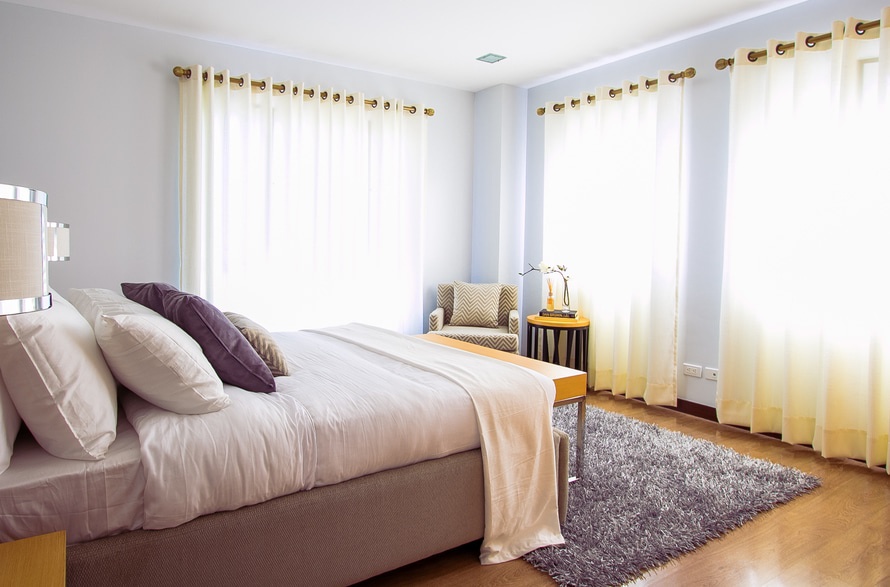It’s a classic conundrum: Staging a home increases its value on the open market, but the whole process can be expensive. You have to shell out to hire a stager and rent furniture and art. If professional staging isn’t in your budget, never fear—it’s entirely possible to do a little DIY staging that won’t break the bank.

Here are some budget-friendly tips and tricks from stagers and Realtors® that will make over your home for next to nothing—or even for free!
Get free advice
A no-cost—and no-brainer—way to get your home looking good and ready to sell? “Get your Realtor involved,” says Realtor Bill Golden with Re/Max Metro Atlanta Cityside, who has 29 years of experience.
Golden’s basic advice: If a home is vacant, furnish only the main rooms: living, dining, and family. “Otherwise, people have trouble picturing how it can be set up.”
Skip bedrooms, which are generally straightforward, according to layout. Add furniture only if bedrooms are unusually small or oddly shaped, to help define how the space can be used. Finally, clearly define any transitional space with straightforward furniture that demonstrates the space’s function.
Don’t rent a storage unit
Experienced sellers all know the absolute cheapest way to spruce up a home for sale is the critical de-cluttering stage—”the most typical problem” of homeowners, as one staging pro puts it. Still, storage units can be expensive, as can the U-Haul you need to rent to slog your stuff there. So consider some cheaper alternatives.
Depending on the amount you need to stash, Clutter.com offers storage for as little as $7 per month; Makespace.com, $12 per month. These services make it easy, too: They’ll send you boxes, which you fill and mail back to them. Whenever you want your stored stuff just ask, and back it comes.
Slipcover old furniture
Design expert Sam Jernigan at Renaissance Design Consultations of Northern California previously worked at one of the top staging firms in San Francisco and developed a mini-staging service. Her top tip for DIY staging: ready-made slipcovers—including for chairs—that can neutralize dated or too-busy patterns and freshen up worn upholstered pieces. Couch slipcovers start at $79.96 at Sure Fit.
Grab just 1 quart of paint
You already know that most rooms should be painted in a neutral tone. But according to Jernigan, a quart of the right pop of color can play up key architectural features and costs only around $15.
“Is the fireplace or bay window lost amid a sea of same color walls?” she says. “An accent paint will give new focus to important features that are otherwise lost.”
Raise the roof, visually speaking
“Older homes with low 8-foot ceilings benefit from adding strong vertical lines to a room,” says Jernigan. Cut some wild foliage—like 6-foot branches—and place them in a narrow vase. Another trick? Add draperies from a ceiling mount rod to give the room a lift. “Ready-made draperies are now available in 96- as well as 108-inch lengths.” (They start at $29.99 at Ikea.)
Bed-in-a-bag
If a bedroom needs updating, snag bed-in-a-bag bedding ensembles from a discount store (starting at as low as $8 at Target). These low-cost linens can even do double duty as a window treatment in a pinch. Jernigan suggests using the matching sheets—that no one will see under the duvet—as curtains.
Quick bathroom face-lift
If a complete gut job isn’t in the cards for your outdated bathrooms, just paint existing cabinets, add new hardware, and finish with a cloth shower curtain. “Voila! This helps your old bath feel almost as good as new, ” says Los Angeles–based interior designer Sarah Barnard of Sarah Barnard Design.
Pay attention to lighting
Show your home in its best light by purchasing good quality bulbs with appropriate wattage.
“Some bulbs have warmer hues, which are more flattering to skin tones,” says Jernigan. Soft pink bulbs start at two for $2.99.
Hit thrift stores and yard sales
If you need to buy some pieces to stage your home, don’t break the bank unless you’re shopping for furniture you plan to keep. Instead, hit thrift stores and yard sales. Better yet, borrow pieces from friends or family.
“You’d be surprised how many people have an attic or basement full of furniture that they’re not using,” says Golden. “A desk can stand in as a dining table, and clean, appropriately scaled outdoor furniture can be used inside.”
Banish outdated decor
Zero in on yesteryear’s decor “such as silk flowers and outdated curtains,” says Colby Sambrotto, CEO and founder of USRealty.com. This includes updating one of the first things buyers see when they pull up: the house number.
“Make sure the numerals are in a style consistent with the architectural design of the house,” Sambrotto says. Sometimes it’s the small things that make a big (initial) impact.
Create homey vignettes
Stage for everyday living with bouquets of fresh flowers and bowls of fresh fruit. This kind of staging is basically free—”it means setting dining tables and creating small vignettes like a folded newspaper with a coffee cup on a tray by a chaise lounge,” says Jernigan. “These small touches spell home, especially our idealized version of home.”
Published by Margaret Heidenry on realtor.com.
